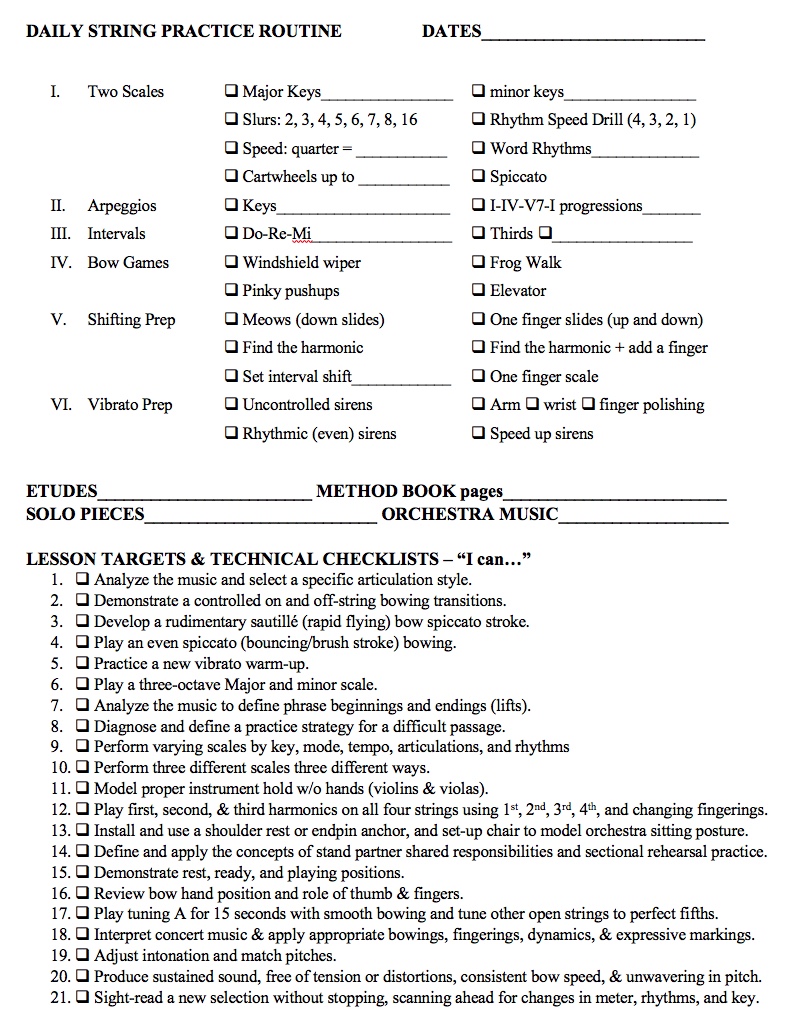It’s all about defining focus, setting goals, practicing, and methodically solving problems!
A good way to “warm-up” to the benefits of making a personal practice diary, check out this video of cellist Sarah Joy “A Look Inside My Practice Journal.” https://www.youtube.com/watch?v=253UMKMfOoc.
(She has quite a collection of YouTube releases… everything from sight-reading tips to structuring your practice time. They are short and sweet!)
So, let’s get started with the “why” and “how” of using practice journals…
I asked the South Hills Junior Orchestra members to give me their insight on how they prioritize/plan their practice time. Thankfully, I received a thoughtful response from one of our violinists, Nicolette:
For practicing, I usually start out with a scale. Then, I’ll play a couple etudes I have. However, I won’t play all of them, instead I’ll leave some to play at the end of my practice. Then, I’ll move on to some of my easier pieces to practice. Moving on from that, I’ll play my harder pieces, or my orchestra music. I usually try to change it up a bit so I don’t get bored. Then I’ll finish up with the rest of my etudes. After I’m done practicing, I usually try to write in my practice journal. Whenever I practice, I will keep out my notes from my teacher and my practice journal to look back at while practicing.
For my practice journal, I try to write in it whenever I remember, because I would be lying if I said I wrote in it every day. When I do write in my practice journal, I write down what I need to practice the next day, whatever I was having difficulty with that day, and maybe some notes my teacher gave me.
If I’m starting to feel stressed and frustrated, or if I’m starting to get bored with practicing, I’ll start listening to music. The music can vary, but I mostly stick to musicals.
What do the experts say some of the rationales for maintaining a written journal for any serious educational pursuit?
- It defines targets for a more efficient use of time. http://www.essential-music-practice.com/efficient-practice.html
- Promotes accountability. http://theaspiringguitarist.net/guitar-practice-journal/
- Documents progress. https://www.musicindustryhowto.com/the-musicians-practice-journal-and-why-you-need-one/
- Keeps track of details. https://music.stackexchange.com/questions/3299/do-music-students-find-practice-journals-useful
- Harnesses creativity. https://lifehacker.com/why-you-should-keep-a-journal-and-how-to-start-yours-1547057185
- Explores what is important to you. http://blog.connectionsacademy.com/5-reasons-for-students-to-keep-a-journal/
What does a typical practice log/diary/journal look like?
The “basics” are lists of specific assignments, warm-ups, musical and technical goals, and repertoire. For example, the Fort Couch Band Director Dr. John Seybert distributes the following simple form to his grades 7-8 band students:

Each entry should be dated and allow space to make comments and goals for your next session of practice. Many musicians divide up the page into segments, such as warmups, scales/exercises, etudes (studies), method book or solo pieces, and ensemble music, each with an area to jot down a narrative of what you did and how well things went.
When I was teaching strings (grades 5-12), my students and I developed an extremely detailed daily practice regime, which included a year’s checklist of lesson targets:

You can make your own “things-to-do” list, including the focal points your music teachers “harp on” for improving form and technique. What does the band or orchestra director say about long tones, tuning, good posture, steady beat, rhythms and note-reading, fingerings, ensemble blend and balance, etc.? Emphasize one or more of these for each practice session!
 In your “customized” journal, I recommend leaving space for metronome markings, special articulations, practicing tips and instructions (like “repeat it three-times-in-a-row perfectly” or “work on measures #1-8 today, #5-12 tomorrow,” etc.) and time spent. Remember, you are a problem solver and seek ways to integrate your “tool box of tricks” to learn each challenging passage. What works for you? What doesn’t? That’s the true magic of a journal… in with the good, and out the bad!
In your “customized” journal, I recommend leaving space for metronome markings, special articulations, practicing tips and instructions (like “repeat it three-times-in-a-row perfectly” or “work on measures #1-8 today, #5-12 tomorrow,” etc.) and time spent. Remember, you are a problem solver and seek ways to integrate your “tool box of tricks” to learn each challenging passage. What works for you? What doesn’t? That’s the true magic of a journal… in with the good, and out the bad!
Several previous Fox’s Firesides have explored practice methods and the setting of goals: http://www.shjo.org/foxs-fireside/. There are many other online resources, samples, and articles about practice journals. A few sites try to sell you printed forms, but others just offer you advice on creating and using documents to set practice goals. Take time to peruse these:
- “Start Small, Win Big” https://www.thepracticejournal.com/blogs/the-practice-journal-blog/start-small-win-big
- “How to Bullet Journal Practice” https://www.youtube.com/watch?v=iTABUNHmczs
- “Ten Noteworthy Music Apps for Productive Practicing” https://shenoted.com/2014/09/16/10-noteworthy-music-apps-for-productive-practicing/
- Blogs at “Musician’s Way” like https://www.musiciansway.com/blog/2009/11/the-power-of-specific-goals/
- “Daily Practice Planner” https://faculty.ithaca.edu/mauk/docs/dailypracticeplanner.pdf
- “How to Practice – Five Habits to Help Make Your Music Practice More Efficient and Effective” http://www.essential-music-practice.com/support-files/how-to-practice-five-habits-to-help-you-make-more-progress.pdf
- “Practice – A How-To Guide and Workbook for Music Students” https://docs.wixstatic.com/ugd/b6966e_a29f9fc2e51746d6902666074f16d214.pdf
- “Practice Diary” https://www.musiciansunion.org.uk/Files/Forms/Education/Practice-Diary
What do you have to lose? Try setting up and maintaining a practice journal! It may improve the value and focus of the time you devote to working on your music… and make a real difference in your musical progress! Like Olympic athletes… go for the goals and the gold!
For a printable copy of this article, click here.
Feel free to share all SHJO enrichment resources and “Fox Firesides” at http://www.shjo.org/foxs-fireside/.
PKF
© 2018 Paul K. Fox


